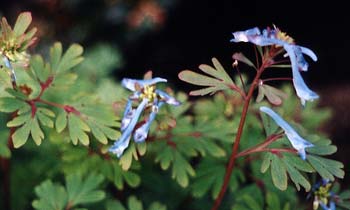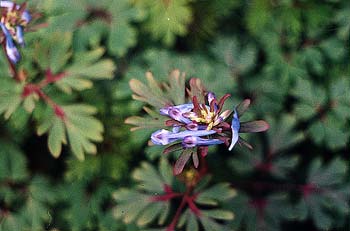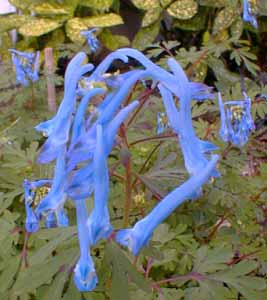 'Blue Panda' Corydalis:
'Blue Panda' Corydalis:
A school of fish swimming over the foliage
This shade-lover grows from a corm in fragile-looking clumps of divided leaves. I obtained this years ago without a label, but there were not so many cultivars available at the time, so I'm confident it is 'Blue Panda.'
'Blue Panda' will die to the ground at about the height of summer if the ground dries out, or if kept perpetually moist & protected from sun, it suffers through the height of summer getting a mite thin & scruffy, leaping back to life for another flowering in Autumn before slowly vanishing into the ground for winter.
It's "gone" very briefly. Here on Puget Sound it almost instantaneously grows back, providing a shorter ferny groundcover through much of winter. It gains very little height to the young cold-season foliage until February, when it begins to build itself into a foot-high mound.
 As early as the start as February it has a few pretty blue flowers starting, & by early March it sends up many faintly fragrant spurred flowers that look like schools of sky-blue fish skimming the surface of the leaves. Some see it as a pipe-fish or seahorse, but to me these look quite clearly like minnows, some of them with their mouths wide open as if to eat mosquito wigglers. By April it is just thick with blue flowers that persist & persist.
As early as the start as February it has a few pretty blue flowers starting, & by early March it sends up many faintly fragrant spurred flowers that look like schools of sky-blue fish skimming the surface of the leaves. Some see it as a pipe-fish or seahorse, but to me these look quite clearly like minnows, some of them with their mouths wide open as if to eat mosquito wigglers. By April it is just thick with blue flowers that persist & persist.The first two photographs on this page were taken in March 2002. The third photo is from March 2004. In a shady perpetually moist location, barring too hot a summer, it will sometimes be ever-blooming for three seasons, or can at least be helped to keep its summer estivation brief. Usually 'Blue Panda' requires a good trim to remove any dried out bits for August, then it will immediately start over. It does spectacularly well alongside it's relative, Bleeding Hearts, other corydalis species, & ferns.
 I'm extremely fond of corydalis species & have several different species & varieties. C. lutea with spurred yellow blossoms was very summer-hardy, but died out of the garden in winter & did not come back. C. ophiocarpa with tubular ivory blooms with deep red tips thrived, but surprised me by its homeliness as it got bigger, & I ended up composting it. C. leucanthema 'Silver Spectre' with silver-mottled leaves & delicate lavender flowers, very pleasing. C. elata has a more upright growth habit, the familiar blue guppy-flowers, & is completely summer-hardy. C. x flexuosa 'Blackberry Wine' has transluscent purple guppy-flowers. C. scouleri is a large locally native corydalis that gets taller than any of the others, having frosted bright green leaves, & magenta guppies. Plus we've sundry Dicentra species of similar disposition & novel flowers.
I'm extremely fond of corydalis species & have several different species & varieties. C. lutea with spurred yellow blossoms was very summer-hardy, but died out of the garden in winter & did not come back. C. ophiocarpa with tubular ivory blooms with deep red tips thrived, but surprised me by its homeliness as it got bigger, & I ended up composting it. C. leucanthema 'Silver Spectre' with silver-mottled leaves & delicate lavender flowers, very pleasing. C. elata has a more upright growth habit, the familiar blue guppy-flowers, & is completely summer-hardy. C. x flexuosa 'Blackberry Wine' has transluscent purple guppy-flowers. C. scouleri is a large locally native corydalis that gets taller than any of the others, having frosted bright green leaves, & magenta guppies. Plus we've sundry Dicentra species of similar disposition & novel flowers.It is C. flexuosa which seems to be the most popular of all the Corydalis species in Northwest gardens, as you just can't beat those blossoms that look as though they are made out of the finest & thinnest eggshell china. It is surprisingly recent in the nursery trade, having been brought back from Western China only in 1989 by famed British plant hunters James Compton, John d'Arcy & Martyn Rix. Our Puget Sound weather suits it better than any other zone, & many gardeners will just never know its pleasures since it is hardy outside our moderate temperate zone.
'Blue Panda' was the first cultivar to be widely distributed. Because it nearly always goes dormant & begins to die back around August (coming back for an Autumn rebloom), much breeding has been done to make it hardier in summer. We have a clump of the cultivar 'Purple Leaf' a.k.a. 'Purple Dragon,' that is much stronger in summer. Appearance-wise, the purple tint to its leaves is not overt, & most C. flexuosa cultivars look very much alike.
The above descriptions of behavior of 'Blue Panda' really only applies to this one clump. There is considerable variation in their behavior one cultivar to the next, one garden location to the next, & especially one climate to the next.
Puget Sound weather is perfect for this species, but it would be delicate in even slightly warmer areas. Northwesterners should thank the Gods of China that our weather matches that of this flower's native habitat in the Woolong Valley of Sichuan Province, which is the heart of panda country, where it grows amidst the bamboo.
On Puget Sound, it is not at all as fragile as its ferny appearance hints it should be. It is very hardy just so long as it never dries out. But elsewhere it can be a difficult plant needing deep mulching to survive particularly harsh winters, with the mulch cleared away for spring. In really hot areas, gardeners probably just have to forget it & stick with other Corydalis species that aren't so fussy about demanding a temperate experience, or else think of it as an annual that blooms once & then expires.